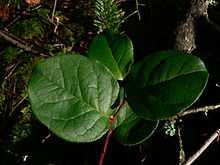Gaultheria shallon
| Gaultheria shallon | |
|---|---|
 | |
| Scientific classification | |
| Kingdom: | Plantae |
| (unranked): | Angiosperms |
| (unranked): | Eudicots |
| (unranked): | Asterids |
| Order: | Ericales |
| Family: | Ericaceae |
| Genus: | Gaultheria |
| Species: | G. shallon |
| Binomial name | |
| Gaultheria shallon Pursh | |
Gaultheria shallon is a leathery-leaved shrub in the heather family (Ericaceae), native to western North America. In English, it is known as salal, shallon, or simply Gaultheria in Britain.
Description

Gaultheria shallon is 0.2 to 5 metres (0.66 to 16.40 ft) tall, sprawling to erect. Evergreen, its thick, tough, egg-shaped leaves are shiny and dark green on the upper surface, and rough and lighter green on the lower. Each finely and sharply serrate leaf is 5 to 10 centimetres (2.0 to 3.9 in) long. The inflorescence consists of a bracteate raceme, one-sided, with 5 to 15 flowers at the ends of branches. Each flower is composed of a deeply five-parted, glandular-haired calyx and an urn-shaped pink to white, glandular to hairy, five-lobed corolla, 7 to 10 millimetres (0.28 to 0.39 in) long. The reddish to blue, rough-surfaced, hairy, nearly spherical fruit is 6 to 10 millimetres (0.24 to 0.39 in) in diameter.[1]
Ecology
Gaultheria shallon is tolerant of both sunny and shady conditions at low to moderate elevations. It is a common coniferous forest understory species and may dominate large areas. In coastal areas, it may form dense, nearly impenetrable thickets. It grows as far north as Baranof Island, Alaska.[1] Western poison oak is a common associate in the California Coast Ranges.[2]
Edibility

Its dark blue "berries" (actually swollen sepals)[1] and young leaves are both edible and are efficient appetite suppressants, both with a unique flavor. Gaultheria shallon berries were a significant food resource for native people, who both ate them fresh and dried them into cakes. They were also used as a sweetener, and the Haida used them to thicken salmon eggs. The leaves of the plant were also sometimes used to flavor fish soup.[1]
More recently, Gaultheria shallon berries are used locally in jams, preserves and pies.[1][3] They are often combined with Oregon-grape because the tartness of the latter is partially masked by the mild sweetness of Gaultheria shallon.
Europe
Gaultheria shallon was introduced to Britain in 1828 by David Douglas, who intended the plant to be used as an ornamental.[1] There, it is usually known as shallon, or, more commonly, simply Gaultheria, and is believed to have been planted as cover for pheasants on shooting estates.[citation needed] It readily colonises heathland and acidic woodland habitats in southern England, often forming very tall and dense evergreen stands which smother other vegetation. Although heathland managers widely regard it as a problem weed on unmanaged heathland, it is readily browsed by cattle (especially in winter), and so where traditional grazing management has been restored the dense stands become broken up and the plant becomes a more scattered component of the heathland vegetation.
Etymology
Both salal and shallon are presumed to be of Native American origin: the former from Chinook Jargon sallal,[4] and the latter from a native word whose pronunciation was recorded by Lewis and Clark as "shelwel, shellwell".[5] The genus Gaultheria was named by Pehr Kalm for his guide in Canada, fellow botanist Jean-François Gaultier.[6]
Medicinal properties
Gaultheria shallon has been used for its medicinal properties by local natives for generations. The medicinal uses of this plant are not widely known or used. However, the leaves have an astringent effect, making it an effective anti-inflammatory and anti-cramping herb. By preparing the leaves in a tea or tincture, one can take the herb safely to decrease internal inflammation such as bladder inflammation, stomach or duodenal ulcers, heartburn, indigestion, sinus inflammation, diarrhea, moderate fever, inflamed / irritated throat, and menstrual cramps. A poultice of the leaf can be used externally to ease discomfort from insect bites and stings.[7]
Economic use
In the Pacific Northwest, the harvesting of Gaultheria shallon is the heart of a large industry which supplies cut evergreens worldwide for use in floral arrangements. It is used in native plant gardens.
References
- ↑ 1.0 1.1 1.2 1.3 1.4 1.5 Jim Pojar and Andy MacKinnon, ed. (2004). Plants of the Pacific Northwest Coast (in English language) (Revised ed.). Vancouver: Lone Pine Publishing. p. 53. ISBN 978-1-55105-530-5.
- ↑ C.Michael Hogan (2008) Western poison-oak: Toxicodendron diversilobum, GlobalTwitcher, ed. Nicklas Stromberg
- ↑ Clarke, Charlotte Bringle (1978). Edible and Useful Plants of California. University of California Press. ISBN 978-0-520-03267-5.
- ↑ salal, Oxford Dictionaries. April 2010. Accessed 2 August 2012.
- ↑ shallon, Oxford English Dictionary Second edition, 1989; online version June 2012. Accessed 2 August 2012.
- ↑ Biography of Jean-François Gaultier, Dictionary of Canadian Biography, 1741-1770 (Volume III). Accessed 2 August 2012.
- ↑ Michael Moore, Medicinal Plants of the Pacific West, illustrated by Mimi Kamp, published by Red Crane Books, Inc. ISBN 1-878610-31-7
| Wikimedia Commons has media related to Salal. |
External links
- USDA Plant Profile – http://plants.usda.gov/java/profile?symbol=GASH
- Gaultheria shallon in The Oregon Encyclopedia